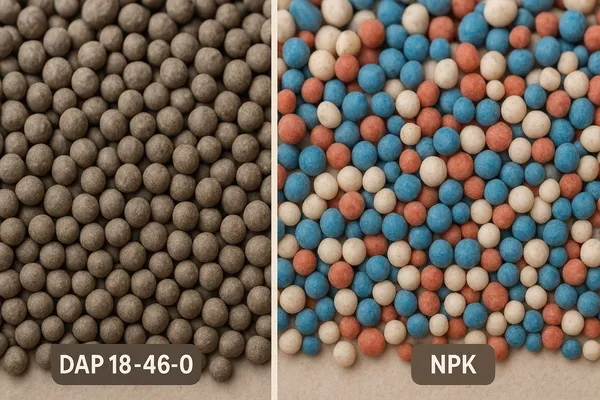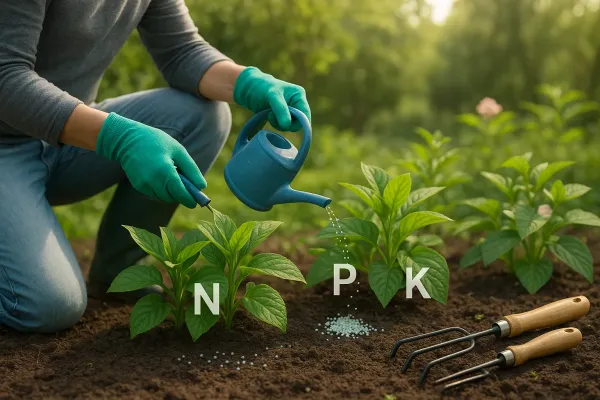Avoid your inquiry is delay response, please enter your WhatsApp/Skype along with the message, so we can contact you at the very first time.
We will reply you within 24 hours. If for urgent case, please add WhatsApp/WeChat:
Warning: Undefined variable $public in /www/wwwroot/lvfertilizer.com/wp-content/themes/hyhadmin/header.php on line 350
Warning: Trying to access array offset on value of type null in /www/wwwroot/lvfertilizer.com/wp-content/themes/hyhadmin/header.php on line 350
,. Or call
Warning: Undefined variable $public in /www/wwwroot/lvfertilizer.com/wp-content/themes/hyhadmin/header.php on line 350
Warning: Trying to access array offset on value of type null in /www/wwwroot/lvfertilizer.com/wp-content/themes/hyhadmin/header.php on line 350
directly.
Bad fertilizer choices burn money and cut yield. Many buyers want one bag for all fields. I do not do that. I match product to soil, crop, and stage.
Neither DAP nor NPK is “better” in every field. DAP supplies nitrogen and phosphorus only. NPK supplies nitrogen, phosphorus, and potassium. I choose after soil tests, crop goals, water quality, and timing.
I start with the limiting nutrient. I add what is missing first. Then I set the ratio for the next growth step. This keeps plans clear. It also keeps results steady across seasons and teams.
Many buyers mix up product names and grade numbers. That causes wrong orders and field delays. I remove this confusion before I plan any pass or stock mix.
DAP is diammonium phosphate, usually 18-46-0. It is one material. NPK is a category of blends or compounds that supply all three primary nutrients. The numbers show the ratio, like 20-20-20 or 15-15-30.

DAP meaning vs NPK meaning
I keep words simple with my team so we move fast. DAP is a single fertilizer salt. It brings ammoniacal nitrogen and a strong dose of phosphorus. It does not bring potassium. It is often used as a starter near the seed or as a base tool to lift low soil P. It can also be part of a dry blend. NPK, by contrast, is not one salt. It is any fertilizer that contains N, P, and K together in a set ratio. It can be a compound granular (each granule has all three), a bulk blend (different granules, mixed), or a fully water-soluble powder for fertigation or foliar use. Labels show the three numbers. Those numbers matter more than brand names.
I also watch how these materials behave in soil and water. DAP briefly raises pH around the granule. That can help root safety in some conditions. On high pH soils, that local effect can slow micronutrient uptake if we overuse it. NPK products vary by recipe. Some are chloride-based (KCl). Some use sulfate (K2SO4). Some add trace elements (TE). Some dissolve very clean. Others need more care. I read the fine print. Then I write a simple one-page plan the crew can follow.
| Item | DAP (Diammonium Phosphate) | NPK (Blends/Compounds Category) |
| Typical analysis | 18-46-0 | Many, e.g., 20-20-20, 15-15-30, 12-12-36 |
| Nutrients supplied | N + P only | N + P + K (balanced or skewed) |
| Usual role | Starter P, build low P soils | Balanced feeding; stage-specific ratios |
| Common forms | Granular; sometimes dissolvable with care | Granular compounds, bulk blends, water-soluble crystals |
| Mixing rules | Keep away from Ca/Mg in one stock tank | Check label; most still need A/B tanks |
| Where it shines | P-hungry starts; fields with adequate K | All-around programs; K push for quality traits |
Clear words save time at the warehouse door. They also protect budgets and keep trucks loaded with the right goods.
Many people order DAP by habit. Habit is not a plan. I use it when phosphorus is the main gap and potassium is already fine.
I use DAP at planting on low-to-medium P soils, in cool starts, and in programs that need N and P only. I place it near the seed but not on it, and I water it in if soils are dry.
I reach for DAP when seedlings must anchor fast. Early roots need energy. Phosphorus provides it. In cool soils, P moves slowly, so a local source near the seed helps a lot. DAP also brings a small shot of ammoniacal N for enzyme function. I place it as a band or side-dress, not in direct seed contact. In cereals, oilseeds, maize, and many vegetables, this simple step improves stand vigor. It also reduces the urge to overwater young crops.
When soil K is at target, DAP is a clean P tool in a base plan. I can pair it with urea, ammonium sulfate, or later with potash if K trends down. For fertigation, I prefer MAP or MKP as the phosphate source because they dissolve cleaner. I can dissolve DAP with care if my water is soft and my target pH is right. I always run a jar test with my own water before I mix stock solutions.
I also use DAP to rebuild P-poor soils over seasons. I split applications, place them well, and track soil test P each year. Once we hit the target range, I taper DAP and bring in balanced NPK or higher-K grades for fruit quality.
I learned restraint from a real case. A grower kept stacking DAP on high pH calcareous soil. Yields flattened. Leaf tissue P looked fine, but iron and zinc went short. We cut DAP, moved part of the P to MAP through drip in the B tank, kept calcium nitrate in the A tank, and added chelated Fe and Zn. The field greened evenly. Yield rose without adding cost.
| Use case | Why DAP fits | Key practice | Watch outs |
| Starter at planting | High P supports roots and early vigor | Band or side-dress; avoid seed contact | Salt injury if placed on seed |
| Cool early season | P mobility slows in cold soil | Localized P near roots | Do not over-apply; watch soil pH |
| P-deficient soils | Build soil test P over time | Split passes; retest yearly | Micronutrient tie-up at high pH |
| K already sufficient | Only N and P needed | Pair with urea or AS; monitor K | Do not ignore a falling K trend |
Good placement, clean timing, and basic water-in rules turn DAP from a habit into a high-return tool.
NPK is my main tool when the crop needs balanced feeding or a strong K push. I do not keep one ratio all season. I match the ratio to the job for that week.
I use higher-P NPK at establishment, higher-N for canopy, higher-K for bloom, set, and finish. Water-soluble NPK fits fertigation and foliar. Compound granular NPK fits base dressing and even release.

When to use NPK fertilizer by stage
I plan by stage. At transplant or seedling stages, I choose 10-52-10 or 12-36-12. Roots grab faster. Stress drops. During vegetative push, I switch to 20-20-20, 24-8-16, or 30-10-10. Leaves expand. Stems thicken. At first bloom and fruit set, I raise K with 15-15-30 or 10-10-40. During bulking and finish, I often use 12-12-36+TE or 05-15-45. Quality traits improve: size, firmness, color, and shelf life. This map is easy to teach. It is also easy to track in a logbook.
Water-soluble NPK gives fast response. It dissolves clean and works with drip, sprinkler, or boom. I split doses to lower salt stress, especially in hot spells or pots. I track EC and pH. I avoid big jumps. Compound granular NPK is different. Each granule carries all three nutrients. It spreads evenly and feeds longer. I use it as a base, then I fine-tune with soluble grades.
A small story shows the value. A pepper farm ran one “all-purpose” NPK all season. Plants looked lush. Fruit set lagged. We kept the same total nutrient budget but shifted timing. 20-20-20 early, 12-12-36+TE at first bloom, then 05-15-45 near finish. Fruit count rose. Grade size evened out. Labor did not change. The difference was ratio and timing, not more bags.
| Goal | Good NPK options | Why it works | Notes |
| Rooting / recovery | 10-52-10, 12-36-12 | High P supports energy and roots | Short window; then switch |
| Leaf and stem growth | 20-20-20, 24-8-16, 30-10-10 | N drives chlorophyll and canopy | Watch nitrate rules and EC |
| Flowering / fruit set | 15-15-30, 10-10-40 | K supports set and stress balance | Keep Ca and Mg in program |
| Bulking / finish | 12-12-36+TE, 05-15-45 | K supports sugar flow and firmness | Monitor flavor and color targets |
I also group crops by need. Leafy greens like steady N but need restraint near harvest. Fruit vegetables want K when blooms start. Orchards and vines need split doses around growth flushes. Simple groups make training easy. They also cut waste.
Many buyers blend products to hit a target ratio fast. This can work very well. It can also cause caking, scale, or nutrient loss if we ignore basic rules.
You can dry-blend DAP with many NPKs. Keep blends dry and apply soon. For fertigation, split phosphates from calcium and magnesium salts into separate stock tanks. Always do a jar test with your own water.

Mixing DAP with NPK
Dry blending is common. I blend DAP (18-46-0) with compound NPKs or with K sources like KCl (muriate) or K2SO4 (sulfate). I do it close to application. I load in low humidity. I avoid long storage because blends cake and pull moisture. I match granule sizes so spread patterns stay even. If soils are dry and pH is high, I plan a water-in pass or time the spread before rain. That reduces ammonia loss when the mix includes urea. A small schedule shift can save a lot of nitrogen.
Liquids follow a different logic. Phosphates plus calcium in one stock tank will make scale. That scale will block injectors and emitters. So I run A/B tanks. Tank A holds calcium nitrate and sometimes magnesium nitrate. Tank B holds phosphate sources like MAP, DAP, or MKP, with potassium nitrate if needed. I keep injection points apart. I flush lines. I set pH to a safe range. I always run a jar test with the exact products and my actual water. If I see clouding or grit, I separate those inputs. This habit takes five minutes and saves days of cleanup.
Storage also matters. Open bags in humid rooms turn to rock. I keep pallets on dunnage. I wrap them. I rotate stock by date. I label blends with the day and the field. I do not leave custom blends in a pile for weeks. I use them.
| Pair | Dry blend | One tank stock | Notes |
| DAP + NPK compound | Yes | Often no | Many NPKs already include phosphates; split Ca/Mg sources |
| DAP + Urea | Yes | Sometimes | Water-in on high pH soils to cut volatilization |
| DAP + KCl (MOP) | Yes | No | Fine dry; not in one stock with Ca sources |
| DAP + K2SO4 (SOP) | Yes | No | Fine dry; split tanks in fertigation |
| DAP + Calcium nitrate | No | No | Forms precipitate; always A/B tanks |
| DAP + Magnesium salts | Caution | No | Risk of scale; jar test and separate |
I also teach a simple rule to crews. Change one thing at a time. If we change the grade, we keep the rate. If we change the rate, we keep the grade. That way we learn fast and keep records clean.
DAP shines when phosphorus is the gap and potassium is fine. NPK shines for balanced feeding and K-driven quality. I test, match stage, split tanks, and adjust early. That keeps yield steady and costs low.